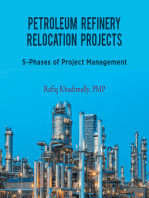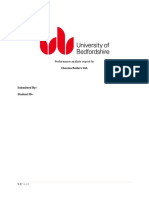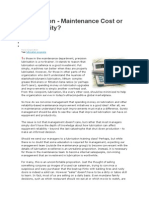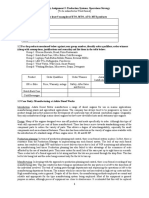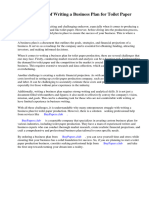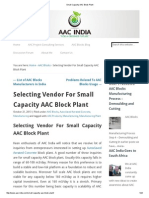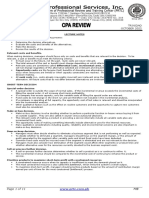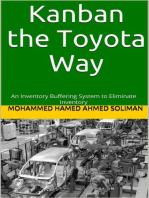0 ratings0% found this document useful (0 votes)
60 viewsCase 1: B&L Inc.: Should Mr. Wilson Proceed Outsourcing Manufacturing or Not?
Case 1: B&L Inc.: Should Mr. Wilson Proceed Outsourcing Manufacturing or Not?
Uploaded by
Manh- Manufacturing mustard in-house would save the company $52,000 per month compared to outsourcing. The total cost of sourcing is $0.756/liter while the total cost of in-house production would be $0.2375/liter.
- There are also additional advantages such as better quality control, increased flexibility and reduced dependency on suppliers, easier sourcing of raw materials, and better utilization of existing labor and inventory space.
- While there may be initial costs and challenges, the company has sufficient facilities, resources, and commitment to overcome these. In-house production aligns with the company's focus on optimization and would provide long-term strategic benefits.
Copyright:
© All Rights Reserved
Available Formats
Download as DOCX, PDF, TXT or read online from Scribd
Case 1: B&L Inc.: Should Mr. Wilson Proceed Outsourcing Manufacturing or Not?
Case 1: B&L Inc.: Should Mr. Wilson Proceed Outsourcing Manufacturing or Not?
Uploaded by
Manh0 ratings0% found this document useful (0 votes)
60 views4 pages- Manufacturing mustard in-house would save the company $52,000 per month compared to outsourcing. The total cost of sourcing is $0.756/liter while the total cost of in-house production would be $0.2375/liter.
- There are also additional advantages such as better quality control, increased flexibility and reduced dependency on suppliers, easier sourcing of raw materials, and better utilization of existing labor and inventory space.
- While there may be initial costs and challenges, the company has sufficient facilities, resources, and commitment to overcome these. In-house production aligns with the company's focus on optimization and would provide long-term strategic benefits.
Original Title
HW3-Case 1
Copyright
© © All Rights Reserved
Available Formats
DOCX, PDF, TXT or read online from Scribd
Share this document
Did you find this document useful?
Is this content inappropriate?
- Manufacturing mustard in-house would save the company $52,000 per month compared to outsourcing. The total cost of sourcing is $0.756/liter while the total cost of in-house production would be $0.2375/liter.
- There are also additional advantages such as better quality control, increased flexibility and reduced dependency on suppliers, easier sourcing of raw materials, and better utilization of existing labor and inventory space.
- While there may be initial costs and challenges, the company has sufficient facilities, resources, and commitment to overcome these. In-house production aligns with the company's focus on optimization and would provide long-term strategic benefits.
Copyright:
© All Rights Reserved
Available Formats
Download as DOCX, PDF, TXT or read online from Scribd
Download as docx, pdf, or txt
0 ratings0% found this document useful (0 votes)
60 views4 pagesCase 1: B&L Inc.: Should Mr. Wilson Proceed Outsourcing Manufacturing or Not?
Case 1: B&L Inc.: Should Mr. Wilson Proceed Outsourcing Manufacturing or Not?
Uploaded by
Manh- Manufacturing mustard in-house would save the company $52,000 per month compared to outsourcing. The total cost of sourcing is $0.756/liter while the total cost of in-house production would be $0.2375/liter.
- There are also additional advantages such as better quality control, increased flexibility and reduced dependency on suppliers, easier sourcing of raw materials, and better utilization of existing labor and inventory space.
- While there may be initial costs and challenges, the company has sufficient facilities, resources, and commitment to overcome these. In-house production aligns with the company's focus on optimization and would provide long-term strategic benefits.
Copyright:
© All Rights Reserved
Available Formats
Download as DOCX, PDF, TXT or read online from Scribd
Download as docx, pdf, or txt
You are on page 1of 4
CASE 1: B&L INC.
Should Mr. Wilson proceed outsourcing manufacturing or not?
First, it was clearly stated that, in B&L Co., all departments working are independent on each
other for raw material and finished products. The outsourcing production of some process to
outside will make disturbance in production flow.
Even it is stated the Mayes are local manufacturer and will supply as much as quantity required
for production, it may make production flow ideal for waiting of the receipt of material from
Mayes.
The given for each trailer, it required 20 brackets so, considering annual production of trailers
of 40. It requires almost 800 brackets per year to fulfill the requirement for sales. So that, B&L
needs to maintain the sufficient inventory to support production. Thus, will increase
unnecessary holding cost of 20% for company.
The total fixed cost of the company containing brackets manufacturing process share to almost
20% which will not be recovered from save if some will be outsourced and burden of some may
be bare by other processes in the future which will make them expensive in future terms.
So, considering the above points it will be suggested, outsourcing manufacturing of outriggers
brackets to Mayes will not be good decision from future perspective and B&L Co. should be
manufacture same inhouse only.
CASE 2: RONDOT AUTOMOTIVE
What action the managers should do based on the report of Glenn?
The plant of Rondot Automotive in Jackson is facing difficulties in management, there is
pressure to lower costs and regain market share. Now let us consider the two alternatives in
term of cost saving and potential market share
The retaining of the wet-paint system
The cost for cleaning and painting operations are approximately 25¢ for each housing, showing
little potential saving if Rondot Automotive decide to upgrade this system. Plus, in near future,
the system will have gone modifications to meeting environmental regulations, and also, have
continued to be depreciated after 17 years in usage. Besides, the same painting method shows
no potential gain in market share.
Outsourcing to Greven E-Coat
The samples sent from Greven is promising: 5 out of 6 families of housings can be converted to
e-coating at a cost of 15¢ each, saving a portion of (25-15)/25 = 40% cost of painting the
housings, compared to the wet-paint system. In terms of economic aspects, this alternative is
preferred.
For potential gain in market share, the new technology of e-coating – if advertised effectively,
could help improve significantly the market share of Rondot Automotive, for its innovative
application of and the painting show similar quality to the wet-paint system. Although
outsourcing means being dependent on the outsider party of Greven, in the long run, there are
possibility for Rondot Automotive in Jackson plant to study, analyze and eventually take up the
technology of e-coating. They can also build up their own e-coating system, after years of
outsourcing to Greven, on the smaller ground area than that used for the wet-paint system.
This alternative has two requirements. The first is the adjustment of the adhesion method used
for the last family of housings, from cold-bond adhesion to hot-bond one, and this has high
chances of being effective as for the other 5 families of housings. The second is the shutting
down of the old painting system, and probably uninstallation and selling in salvage. Yet this is
not urgent and the wet-paint system could buffer the painting job in case of unexpected delay
from Greven.
Based on the report of Glenn, the managers of Rondot plant should flow his the outsourcing
option, for the sake of financial status of the plant and their share in the motor market,
accompanied with several potential innovation of painting system to not only the local Jackson
plant, but to the Rondot Worldwide as well. Here what the managers need to do:
- Form and carry out as soon as possible the contract of outsourcing painting to Greven E-
coating.
- Adjust the adhesion method used for the last family of housings, from cold-bond to hot-
bond, refilling the remained 40% of the Jackson plant’s housing volume.
- Cut off the operation rate of the wet-paint system once the outsourcing contract
become in use, plan for
- Maintain strict provision and quality control of the e-coated housings from Greven.
- Analyze and study the e-coat technology to ensure self-control in the future.
CASE 3. ALICIA WONG
Should the company manufacture mustard in-house?
We have:
Total cost of sourcing = Cost of Mustard per ltr + Freight cost per ltr + Handling cost per ltr +
Other overheads per ltr = $ 0.32/ltr + $ 0.04/ltr + $ 0.016/ltr + $ 0.02/ltr = $ 0.756 /ltr
Total cost of in-house = 60% x Landed Cost of spice blend + 20% x cost per ltr of Vinegar + 20% x
cost per ltr of Water + Labor and overheads (This is because mustard is prepared using 20%
vinegar and 20% water in addition to the spice blend @ 60%) = $ 0.15/ltr x 0.6 + $ 0.1875/ltr x
0.2 + $ 0.025/ltr x 0.2 + $ 0.105/ltr = $ 0.2375/ltr
The difference here is $ 0.756 /ltr - $ 0.2375/ltr = $ 0.5185/ltr.
Now multiply that to the number of liters TFL would order every month: $ 0.5185/ltr * 100.000
ltr = $51850/ month. The company would save almost $52000 every month if it chooses to
produce mustard in-house.
=> Hence we can confirm that it is feasible to make mustard in house and it is cheaper than
buying from outside sources.
Plus there are many advantages to switching to insourcing:
- The company will have better quality management now that it produces mustard on its
own. Given the fact that mustard is a very important materials for TFL’s products, being
able of personalizing it as well as controlling it can be a great plus.
- TFL values and intends to computerize its manufacturing process, therefore, with more
control when insourcing, TFL can use its past experience of applying technology as well
as help integrating this process successfully into its manufacturing chain. This can help
reduce cost, enhance information control, improve upgrading abilities, reduce failure
rates and so on. In the long run, the investment would be worth it.
- Importantly, the increase in flexibility means a reduction in dependency. This will result
in higher responsiveness within the market. TLF won’t have to rely on other suppliers,
reducing the risk that it might happen during the producing process. Also, if it needs for
emergency, it can always produce on its own.
- Plus, sourcing the raw materials such as mustard spice blend is easier given the fact that
it is very available in the market. Many suppliers are competing, hence lowering the
cost.
- Vinegar is already a raw material that TFL order in bulk. Ordering more for the making of
mustard would not be that much of a problem. Plus, the water is readily stably provided
by the city.
- Notice that TFL has a lot of labor, therefore choosing in-house producing would help use
up more of the workers’ existing time. It is said in the paper that TFL has both the time
and resources to help switch to in-house production.
- In fact, workers are supporting the idea, acknowledging that the transition would help
the process turn out more smoothly given the fact that they would not have to haul and
rinse the bulky drums which can be quite an ineffective use of human labor.
- The inventory space used for storing the drums can now be used for other purposes.
Since the company can produce mustard and use mostly right away, there probably
won’t be as much need in storing a bunch of drums at the same time as earlier when it
has to order from the supplier.
- Additionally, it can definitely bring about some hardships. For example, more
investment cost, higher labor cost, harder to control and approve of quality, testing time
for spice blend, the quality might change, training needed for employees,…However,
these can totally be fixed with the right time, money, as well as commitment. Given the
possible long-term benefits, the choice of production transition is totally feasible and
worthy.
All in all, given its past normal approach to the production decision, in-house production of
mustard can definitely be done. It has invested more than $2mil in plant facilities, the bulk of it
being new, state of the art, process equipment and process control. Hence with the possible
advantages regarding optimization, cost reduction, labor efficiency, the company has all the
reasons to give it a try. This method can really be a significant boost for the TFL.
You might also like
- Bridgeton Industries Case Study - Designing Cost SystemsDocument2 pagesBridgeton Industries Case Study - Designing Cost Systemsdgrgich0% (3)
- HW3 SolutionDocument6 pagesHW3 SolutionAnh Cao Thị MinhNo ratings yet
- Donner Company Case AnalysisDocument5 pagesDonner Company Case Analysisarvinddj80% (5)
- Petroleum Refinery Relocation Projects: 5-Phases of Project ManagementFrom EverandPetroleum Refinery Relocation Projects: 5-Phases of Project ManagementNo ratings yet
- LeanBooklet in OrderDocument32 pagesLeanBooklet in OrderioanchiNo ratings yet
- Case Study of Process PlanningDocument4 pagesCase Study of Process PlanningArkew Bogale67% (3)
- Bayonne MemoDocument4 pagesBayonne MemoJohn Barry100% (1)
- Aarohan Case StudyDocument4 pagesAarohan Case StudynisargNo ratings yet
- Chapter 5 - Recruitment and Selection 100 YearsDocument14 pagesChapter 5 - Recruitment and Selection 100 YearsManhNo ratings yet
- Chapter 5 - Recruitment and Selection 100 YearsDocument14 pagesChapter 5 - Recruitment and Selection 100 YearsManhNo ratings yet
- IB Economics Notes - Chapter 8Document21 pagesIB Economics Notes - Chapter 8Anindya Wardhana100% (2)
- Chapter 10 Relevant Cost Concepts in Decision MakingDocument11 pagesChapter 10 Relevant Cost Concepts in Decision MakingadamNo ratings yet
- National Cranberry Cooperative 1981Document10 pagesNational Cranberry Cooperative 1981Nicole Dorado0% (2)
- Pay Back of Right-First-Time - RFT - ProcessingDocument2 pagesPay Back of Right-First-Time - RFT - ProcessingRezaul Karim TutulNo ratings yet
- Cheema Boilers LTD.: Performance Analysis Report ForDocument6 pagesCheema Boilers LTD.: Performance Analysis Report ForSaurabh SinghNo ratings yet
- Painting 3 DCDocument7 pagesPainting 3 DCabgwilNo ratings yet
- Lubrication - Maintenance Cost or Opportunity?: Noria CorporationDocument6 pagesLubrication - Maintenance Cost or Opportunity?: Noria CorporationmarcalasanNo ratings yet
- Relevant CostDocument6 pagesRelevant CostbheafabedizonNo ratings yet
- Total Quality ManagementDocument7 pagesTotal Quality ManagementmansoorliveNo ratings yet
- Sougoto DEB Executive (Marketing) Hindustan Newsprint LimitedDocument7 pagesSougoto DEB Executive (Marketing) Hindustan Newsprint Limitedsougoto_debNo ratings yet
- MASE lABDocument3 pagesMASE lABAli Aslam100% (1)
- QM Essay DanielSempereDocument7 pagesQM Essay DanielSempereDanielNo ratings yet
- Business Plan For Toilet Paper ProductionDocument7 pagesBusiness Plan For Toilet Paper Productionprkn26ye100% (1)
- Top 10 Tips Jan-Feb 06Document3 pagesTop 10 Tips Jan-Feb 06jriacosqNo ratings yet
- Group 9Document4 pagesGroup 9elikajohnson5No ratings yet
- Manufacturing Systems-Fleximble Manufacturing Application-Case Study of ZimbabweDocument5 pagesManufacturing Systems-Fleximble Manufacturing Application-Case Study of Zimbabwejosphat muchatutaNo ratings yet
- Glovia Lean ManufacturingDocument16 pagesGlovia Lean ManufacturingALEJANDRANo ratings yet
- Sunwind OverDocument7 pagesSunwind OverSambit PatraNo ratings yet
- Small Capacity AAC Block PlantDocument23 pagesSmall Capacity AAC Block PlantAshokreddy VajralaNo ratings yet
- MARS Final Anshul RoopsiDocument6 pagesMARS Final Anshul RoopsiAnshul GuptaNo ratings yet
- SUnwind A BDocument5 pagesSUnwind A BChetan Duddagi0% (1)
- (Production and Operations Management) Chapter 5 SummaryDocument6 pages(Production and Operations Management) Chapter 5 Summarytrang.ngo71No ratings yet
- Break Even Analysis and Decision MakingDocument216 pagesBreak Even Analysis and Decision Makingkcmiyyappan2701No ratings yet
- L2 Tradable Pollution PermitsDocument8 pagesL2 Tradable Pollution PermitsIrina KorolevaNo ratings yet
- Lean Assessment 1Document5 pagesLean Assessment 1p4prachandNo ratings yet
- Lean OutlookDocument24 pagesLean OutlookcucumucuNo ratings yet
- Manufacturing: Inventory Control SystemDocument4 pagesManufacturing: Inventory Control SystemshakilliyaNo ratings yet
- FOGDocument14 pagesFOGAlex DulayNo ratings yet
- Lean Six Sigma Black Belt Certification Training Manual CSSC 2018 06b 33 45Document13 pagesLean Six Sigma Black Belt Certification Training Manual CSSC 2018 06b 33 45Rocío MTNo ratings yet
- ObermeyerDocument4 pagesObermeyerTim RosenbergNo ratings yet
- Sugar and Its By-Products (Important)Document28 pagesSugar and Its By-Products (Important)Prateek ChitambareNo ratings yet
- A Case Study - JK CementDocument6 pagesA Case Study - JK CementSuzZette TianzonNo ratings yet
- Just in TimeDocument4 pagesJust in TimeMariano RodriguezNo ratings yet
- Name Netid Group Number: Website Link: Tutorial Details Time Spent On AssignmentDocument12 pagesName Netid Group Number: Website Link: Tutorial Details Time Spent On AssignmentJackySuiNo ratings yet
- Production Planning White PaperDocument5 pagesProduction Planning White PaperNany WrdNo ratings yet
- Case Write-Up POMDocument5 pagesCase Write-Up POMAnand SharmaNo ratings yet
- Chapter FiveDocument28 pagesChapter FiveBahredin AbdellaNo ratings yet
- Short-Term DecisionsDocument11 pagesShort-Term DecisionsHannahbea LindoNo ratings yet
- Lean Manufacturing DefinitionDocument5 pagesLean Manufacturing DefinitionLoymeNo ratings yet
- Acoustic Lubrication Handbook 2018 Web PDFDocument20 pagesAcoustic Lubrication Handbook 2018 Web PDFEswin Paico de la CruzNo ratings yet
- Manufacturing Wastes Stream: Toyota Production System Lean Principles and ValuesFrom EverandManufacturing Wastes Stream: Toyota Production System Lean Principles and ValuesRating: 4.5 out of 5 stars4.5/5 (3)
- April Solution For VulaDocument7 pagesApril Solution For VulaJessica albaNo ratings yet
- Midterm ExamDocument167 pagesMidterm Examapi-297834433No ratings yet
- Cemfil Sprayguide WW 12 2008 Rev1Document32 pagesCemfil Sprayguide WW 12 2008 Rev1freidorNo ratings yet
- Md. Osman Gani (Roll-128)Document25 pagesMd. Osman Gani (Roll-128)Osman GaniNo ratings yet
- Paint Shop Life CycleDocument4 pagesPaint Shop Life Cyclebhalchandra2290876No ratings yet
- Reduction in Changeover/Stabilization Time and Improvement of Asset UtilizationDocument35 pagesReduction in Changeover/Stabilization Time and Improvement of Asset UtilizationLucasNo ratings yet
- Why Are Business Planning and Budgeting Critical For Cement ManufacturersDocument10 pagesWhy Are Business Planning and Budgeting Critical For Cement ManufacturersMadanKarkiNo ratings yet
- Lean-based Production Management: Practical Lean ManufacturingFrom EverandLean-based Production Management: Practical Lean ManufacturingNo ratings yet
- SMED – How to Do a Quick Changeover?: Toyota Production System ConceptsFrom EverandSMED – How to Do a Quick Changeover?: Toyota Production System ConceptsRating: 4.5 out of 5 stars4.5/5 (2)
- Takt Time: A Guide to the Very Basic Lean CalculationFrom EverandTakt Time: A Guide to the Very Basic Lean CalculationRating: 5 out of 5 stars5/5 (2)
- Kanban the Toyota Way: An Inventory Buffering System to Eliminate InventoryFrom EverandKanban the Toyota Way: An Inventory Buffering System to Eliminate InventoryRating: 5 out of 5 stars5/5 (1)
- Cost & Managerial Accounting II EssentialsFrom EverandCost & Managerial Accounting II EssentialsRating: 4 out of 5 stars4/5 (1)
- Homework/Assignment: AnswerDocument5 pagesHomework/Assignment: AnswerManhNo ratings yet
- Homework/Assignment: AnswersDocument4 pagesHomework/Assignment: AnswersManhNo ratings yet
- Chapter 4 - Job-Description-Person-Specification-CashierDocument1 pageChapter 4 - Job-Description-Person-Specification-CashierManhNo ratings yet
- HW1 - Sabor CaseDocument3 pagesHW1 - Sabor CaseManhNo ratings yet
- AWS Amazon PrimeDocument11 pagesAWS Amazon PrimeManhNo ratings yet
- Hw1-Group 8Document7 pagesHw1-Group 8ManhNo ratings yet
- Homework 4 - Group 8: Case 1Document2 pagesHomework 4 - Group 8: Case 1ManhNo ratings yet
- PatnaDocument2 pagesPatnasaketroy15515No ratings yet
- Post DLP RambastiDocument17 pagesPost DLP RambastiOrin LegoNo ratings yet
- QUO2182183Document1 pageQUO2182183Josh TingNo ratings yet
- Chapter 5 PAS 8 Accounting Policies, Changes in Accouting Estimates and ErrorsDocument12 pagesChapter 5 PAS 8 Accounting Policies, Changes in Accouting Estimates and ErrorsSimon RavanaNo ratings yet
- ARISE WorksheetsDocument4 pagesARISE WorksheetsMonica Jhane CaguioaNo ratings yet
- Yesakore Transport Business PlanDocument20 pagesYesakore Transport Business PlanAbel GetachewNo ratings yet
- Icis Supply-Demand Brochure 140618 Digital-View1Document16 pagesIcis Supply-Demand Brochure 140618 Digital-View1Yesica RozoNo ratings yet
- Relationship Between GDP SDG Goals and SEEA IndicatorsDocument5 pagesRelationship Between GDP SDG Goals and SEEA IndicatorsVikin JainNo ratings yet
- Gen MathDocument25 pagesGen MathAndreaaAAaa TagleNo ratings yet
- Systematic Risk Vs Unsystematic RiskDocument4 pagesSystematic Risk Vs Unsystematic Riskgaurav112011No ratings yet
- ET Orske Eritas: Type Approval CertificateDocument2 pagesET Orske Eritas: Type Approval Certificatemohamed AdelNo ratings yet
- Impact of Climate Change On Economic Growth in NigeriaDocument14 pagesImpact of Climate Change On Economic Growth in NigeriadareolufowoseNo ratings yet
- US Market Recap November 29Document3 pagesUS Market Recap November 29eldime06No ratings yet
- Declamation - APJ Abdul Kalam Speech by AgastyaDocument1 pageDeclamation - APJ Abdul Kalam Speech by AgastyaPoop MasterNo ratings yet
- 9,10,11Document3 pages9,10,11Karo MotiNo ratings yet
- Portfolio Managemet InternalDocument6 pagesPortfolio Managemet Internalasutoshpradhan36No ratings yet
- Set-Off and Counterclaim CJS HFRDocument4 pagesSet-Off and Counterclaim CJS HFRTitle IV-D Man with a plan100% (5)
- BDP and CapDev Format SampleDocument17 pagesBDP and CapDev Format SamplemarkphilippalpallatocNo ratings yet
- Mariano P. Pascual, Et - Al vs. CIRDocument1 pageMariano P. Pascual, Et - Al vs. CIRVel JuneNo ratings yet
- Trade and InvestmentDocument336 pagesTrade and InvestmentAbdulkadir Al-OthiamNo ratings yet
- Flyer LAGA GrainPlus 4-Seiter EN LQDocument4 pagesFlyer LAGA GrainPlus 4-Seiter EN LQCộc CộcNo ratings yet
- The BrettonDocument2 pagesThe BrettonDraque TorresNo ratings yet
- INFRASTRUCTUREDocument10 pagesINFRASTRUCTURESharanabasappaDegoanNo ratings yet
- Trade Confirmation: Lalu Nurul Ilham Syariah Mandiri, Bei A/C: 7155247783Document2 pagesTrade Confirmation: Lalu Nurul Ilham Syariah Mandiri, Bei A/C: 7155247783ilham ilhamsonhadjiNo ratings yet
- CMO Historical Data AnnualDocument27 pagesCMO Historical Data AnnualDEPRI AFRIAN LAMBUTONo ratings yet
- Amityville Railroad To Halesite: Suffolk County Transit Bus Information Suffolk County Transit Fares & InformationDocument4 pagesAmityville Railroad To Halesite: Suffolk County Transit Bus Information Suffolk County Transit Fares & InformationJustinNo ratings yet
- Trade AnalysisDocument64 pagesTrade AnalysisVishal SakpalNo ratings yet
- Lecture 5-6 BudgetingDocument15 pagesLecture 5-6 BudgetingAfzal AhmedNo ratings yet
- Tugas AKM P21.12 - Kelompok 6Document4 pagesTugas AKM P21.12 - Kelompok 6Adrian PashaNo ratings yet



